
This is an atlatl that was found at the Council Hill site in eastern Nevada back in the 1920's. The original excavations were never published, however, so any information about its origin is lost. It is very similar to ones used by the Basketmaker II culture, however, so it is safe to assume it's from the same era (100 BC - 400 AD). The most unusual feature of this atlatl is the channel that runs nearly the entire length of the atlatl. Keep in mind that this is my interpretation of the original.
Material:
Wood, 20 3/4" x 3/4" x 3/8"
(2) Leather, 1/2" x 4 1/2"
Artificial Sinew
Construction:
- Carve out the finger grips and wrapping spots. The middle one is for your fingers, so it should be the deepest, but try to leave at least 1/2" of wood between them. The depressions on the sides of the finger grips are to hold the sinew in place when wrapping the leather straps.
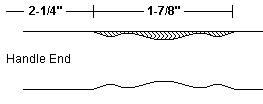
- Carve out the peg and groove. Go down about 1/8" deep. Be sure to undercut the peg so it will grip the dart. The easiest way to do this is to scratch in the outline of the peg, and then score a line running down the shaft for the groove. Keep cutting this groove down, then cut in from the sides to remove the wood.
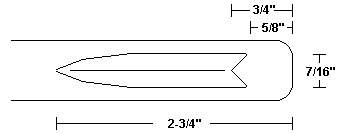
- Drw a line down the exact center of the shaft, from the end of the groove to the handle end. Take your knife and just cut in a little from each side to make the channel.
- Round off all edges and sand.
- If you're going to stain or color the wood, do it now before you attach the finger straps.
- Take one piece of leather and lay it over the top depression (towards the peg end) so that about 1/2" is sticking out past the depression. Glue it in place. Do the same for the other side, and then wrap it in place with the sinew.
- Holding it in your hand as if you were going to throw, find out where the bottom of the leather straps should be located. Glue and wrap them in place over the bottom depression.
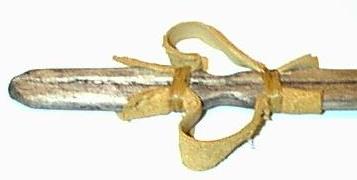

Scan from Great Basin Atlatl Studies

My Council Hill Atlatl
(Made from a piece of lath, colored with Cordovan color shoe wax)

My 2nd Council Hill Atlatl
(Made from a piece of lath, colored with brown shoe wax)

I bought this on ebay, and all they could tell me about it is that it's a reproduction made at the University of Missouri.
Material:
Wood, 23 1/2" x 1 1/2" x 3/4"
Dowel, 3/8" x 1 1/2"
(2) Leather straps, 1" x 5"
Artificial Sinew
Construction:
- Starting 4" from the peg end and 5" from the handle end, thin it to 1" wide in the middle.
- Starting in the same place, thin it to 5/8" high from the bottom.
- 3 1/2" from the handle end, cut out the finger grips. Leave 1" between them.
- Round off both ends.
- 1" from the peg end, drill a 3/8" hole at a 40 degree angle.
- Cut out the groove. Starting 1 1/2" from the peg end, cut it for 2", 3/8" wide, about 1/8" deep.
- Round off all edges and sand.
- Round/taper one end of the dowel. Put glue in the hole and insert the flat end. Push it in firmly.
- Glue 1" of the straps above and below the finger grips. Wrap tightly with sinew.
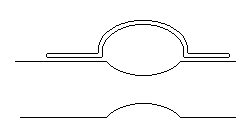

The original has an antler peg, sinew-wrapped leather handles, leather "sleeves" above and below the grips, a wrist strap, and decorative sinew wrapping. It also had smaller fingergrips which were too hard to use, so I've widened them for this version.

This is based on the University of Missouri atlatl. I wasn't too pleased with the original, so I made some modifications to it.
Material:
Wood, 20" x 1 1/0" x 3/4"
Dowel, 3/8" x 1 1/2"
Leather strap, 1" x 9"
Artificial Sinew
Construction:
- Starting 2 1/2" from the peg end and 5" from the handle end, thin it to 3/4" wide in the middle.
- Starting in the same place, thin it to 1/2" high from the bottom.
- Starting 5" from the handle end, cut in and narrow the handle to 3/4" wide.
- Round off both ends.
- 1" from the peg end, drill a 3/8" hole at a 30 degree angle.
- Round off all edges and sand.
- Round/taper one end of the dowel. Put glue in the hole and insert the flat end. Push it in firmly.
- Glue 1" of the straps above the handle on both sides and glue it down. The loop should be on the back of the atlatl (away from the peg). Wrap tightly with sinew.
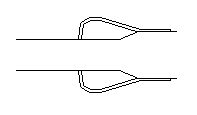
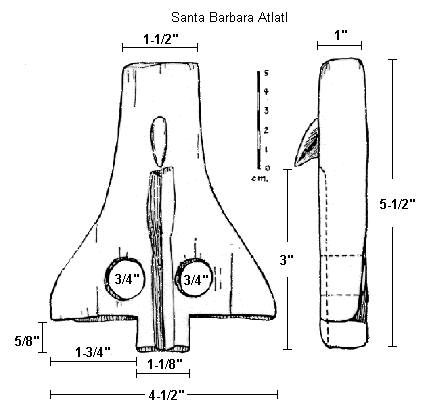
This was found in Santa Barbara, Baja California and is possibly Chumash. It was found in 1793.
The description given is:
"spearthrower of moderately hard, light-coloured wood, pierced with two holes for the first two fingers: the hook is made of a piece of bone rudely shaped. The whole seems to have once been covered with red color, now almost worn away. From the bone hook to the projection at the broad end of the implement is a shallow channel, as is usually found."
This seems too short to be functional. Possibly a children's model.
Material:
Wood, 5 1/2" x 4 1/2" x 1"
Dowel or bone peg
Construction:
- Cut out the basic shape.
- Drill 2 fingerholes, 3/4" in diameter about an inch apart.
- Drill a hole for the peg.
- Carefully carve a v-channel down the center of the board, running in about 3".
- Round the edges and sand it.
- Put some glue in the peg hole and insert the peg, pressing firmly.
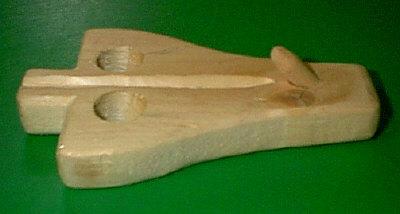

Estimated measurements, based on the Ozark Bluff Dweller atlatl, Arkansas.
Material:
Wood, 18" x 1" x 1/2"
Dowel, 1/4" x 3"
Construction:
- Cut the outline of the atlatl.
- Round off all the edges.
- Taper the peg to a rounded point.
- Drill a 1/4" hole 3" from the handle end.
- Sand it all smooth.
- Put the dowel through the hole and glue it in place.
The best way I've found to hold these is to put your thumb and finger over the dowel, and the rest of your fingers under it. I don't know if that's right, but it works.

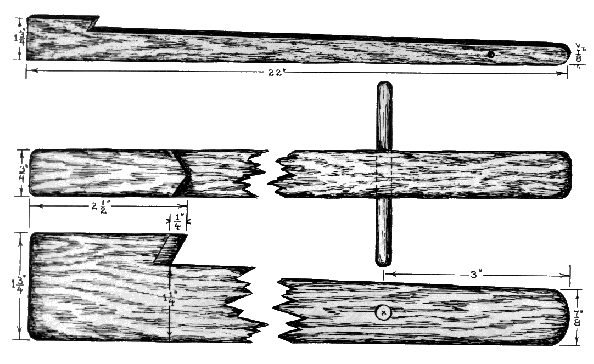
From "Indian Handcrafts"
Material:
Block of hardwood 22" long, 1 3/4" wide, 3/4" thick
Dowel, 1/4" x 3"
Construction:
- Pencil an atlatl stick design on a 3/4-inch hardwood board. After sawing to shape, undercut the hook into a "V" shape to hold the dart arch. Then gently round the edges of the stick.
- Drill a 1/4-inch hole 3 inches from the handle end.
- Glue a 1/4-inch dowel 3 inches long in place for the hand stop.
- You may wish to add an atlatl weight to give the stick more throwing heft.


Based on an atlatl found in Nicolarson Cave, Lake Winnemucca, Nevada. Possibly 8000 years old.
Material:
Wood, 23" x 3/4" x 5/8"
Bone hook, 4" long
Soapstone Atlatl Weight, 7 1/2" long
Artificial Sinew
This is a difficult one, involving wood, bone, and stone. Hope you're up for a challenge!
Construction:
Wood part:
- Starting 13" from the handle end, begin tapering the sides of the shaft to 9/16" at the peg end.
- Starting in the same place, cut the bottom so it slants up to 9/16" at the peg end.
- Round off the tapered area. 5" from the peg end, it should be a circle.
- Flatten off the last 3" from the peg end, tapering down slightly. This is where the bone hook will attach.
- Cut a small groove in the back of the peg end, about 1/4" in. (See picture below).
- The original atlatl had grooves cut into the handle, up to about 4" in. This was for a better grip. It's up to you.
- Round the edges and sand it smooth.
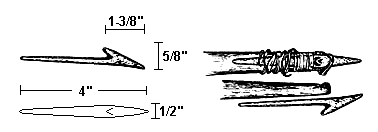
Bone part:
- Take your bone blank and carefully shape the hook as shown. The back (away from the peg) should be flat so it lies on the atlatl. Don't make the point too sharp, or it will break the end of your darts.
- Using glue and artificial sinew, attach the hook as shown.

Stone part:
- Shape the soapstone as shown. It should be 7 1/2" long, 3/4" wide, and about 3/4" high when done, rounded and tapered on top with grooves on either end. The back has to be flat to lie against the atlatl.
- Using glue and artifical sinew, attach the weight as shown.

An article about this atlatl can be found at http://www.atlatl.net/lostandfound.asp?found=2.

Found at Plush Cave, S.E. Oregon. Possibly 1500-2000 years old.
Material:
Wood, 21" x 3/4" x 1/2"
Leather thong, 24" or so
Construction:
- On top, starting 10" from the peg end, slant it down towards the peg leaving the last 1" intact. The end should be 1/8" above the sides.

- Starting at the raised area, cut the groove. It should be 3/8" wide, 1/4" deep, and 7 1/2" long.
- Carve the peg on top, undercutting it to extend the groove.

- Round the bottom and the ends.
- From 3 3/4" to 5 1/4" from the base of the handle, cut out the grips. Leave 1/2" between the sides.
- Cut a shallow groove on the sides and under the bottom just above and below the finger grips. Make the top one a little wider.
- Round all edges and sand smooth.
Fingerloops
From the shape and the grooves, this is probably very similar to a basketmaker atlatl, which had braided leather fingerloops.
Unfortunately, braiding leather is not my strong point, and I have no idea how it used to be done. I know a way that will work, however.

- Fold the thong in half and twist it a few times to form a loop. Slide the loop into the top groove and twist it tight.
- Continue twisting until you have about 3" done. Be careful not to twist it too tightly, though, or it will kink up.
- Bend the twisted section down to the bottom groove and make one twist around the shaft.

- Continue twisting until you have another 3" done, Bend it up to the top groove, twist it around the shaft, and tie it off. Trim off the excess.
An article about this atlatl can be found at http://www.atlatl.net/lostandfound.asp?found=2.

by Dan Hutchison, Apalachee Archery. Posted with his permission.
I'm mixed blood Muskogee[Creek] from south Al. , this is the style my grandfather and great uncle's taught me to make as a child in the 1940's & 50's.
Material:
Wood, 20" x 1" x 1/2" (main board)
Wood, 3" x 1" x 1" (peg block)
Dowel, 5/16" x 1 1/2"
Leather thong, 9" long
Construction:
- 6" from the peg end, start tapering the board down to 1/2" wide at the handle.
- Cut and shape the peg block, leaving about 1/2" flat on top.
- Glue the peg block onto the main board, clamp, and let dry.
- Alternate: Instead of using two pieces of wood, you could cut the rough shape out of one piece (a 2x4 would work nice). Seems like a waste of wood, though, which is why I suggested 2 pieces and gluing them.
- Drill a 1/8" hole though the handle, 5" from the end.
- Drill a 5/16" hole into the peg block at a 40 degree angle, about 1" deep.
- Round off all edges and sand smooth.
- Round/taper one end of the dowel peg. Put glue in the hole and insert the flat end, pushing it in firmly.
- Put the thong through the hole and tie it in back.

The original has an antler peg, a bow-style thong grip, and a rock weight tied on just ahead of the peg block.

by Kris Tuomala. Posted with his permission.
Material:
Wood, 24" x 7/8" x 3/8"
Leather, 1" x 7"
Artificial Sinew
Construction:
Atlatl
- Round off both ends.
- Carve out the peg and groove. Go down about 1/8" deep. Be sure to undercut the peg so it will grip the dart.
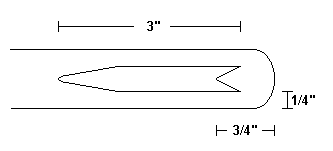
- Cut out the finger grips. Leave 5/8" between them.
- Round off all edges and sand.
- 7" from the peg end, you need to make a slight bend in the wood. Hold that area over steam until the wood is pliable, then bend it over a hard surface and let it set.
Handle
- Cut a 1" slit in the middle of the leather.

- Slide the slit over the handle to just below the finger grips. Glue it in place.
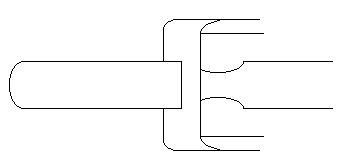
- Put the last 1" of the ends above the finger grips. Wrap them around the shaft, glue them down, and wrap them down with sinew.


I found this image at the World Atlatl Association website. t's a BPS Engineeringdesign.
Material:
Wood, 22" x 3/4" x 3/4"
or Dowel, 3/4" x 22"
Dowel, 3/8" x 1 1/2"
(2) Leather Straps, 1" x 8"
Leather for wrapping handle, 1" wide x 24"
Artificial Sinew
Construction:
- Starting 7" from the handle end, taper it to 1/2" square at the peg end (or 1/2" diameter if using a dowel).
- Cut off the peg end at a 45 degree angle.
- Cut a groove into the peg end, about 1/8" deep by 3/8" wide, running down the slope.

- If you're using the square block, round off all the edges and make the shaft as round as possible.
- Sand it smooth.
- Round/taper one end of the dowel. Glue it into the groove with about 1/4" sticking out of the bottom, then wrap it with sinew and coat it with glue so it dries solid.

- Starting 6" from the handle end, glue the ends of the leather straps on either side of the atlatl.
- Wrap the handle strap around both ends and glue it in place.
- Wrap the handle strap under the loop straps for the finger grip.
- Using 3" of the handle straps, form a loop on either side. Lay the remaining lengths along the side of the atlatl, and cover it with the handle strap, wrapping all the way to the bottom. Glue it in place.


Reproduction atlatl from Texas, made by Travis Mogford.
Material:
Wood, 23 1/2" x 1 1/2" x 3/4"
(2) Leather Straps, 1/2" by 5"
Artificial Sinew
Construction:
- Thin the top of the atlatl. Starting 1 1/2" from the peg end, cut down 1/4" and remove it to the handle end.
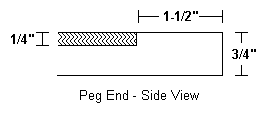
- Starting 2 1/2" from the handle end, thin it to 1" wide at the end.
- Hollow out the "belly", starting 3/16" from either edge. Make it 1/4" deep in the middle.

- Carve out the peg and continue the "belly" around it. Bring the tip to a point and undercut it.

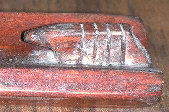
- Round the bottom to match the top, leaving 1/4" of wood.

- From 3 3/4" to 5" from the handle end, cut out the fingergrips. Leave 3/4" between them.
- Round all edges and sand smooth.
- Drill (4) 1/8" holes on both sides, 2 above and 2 below the fingergrips.
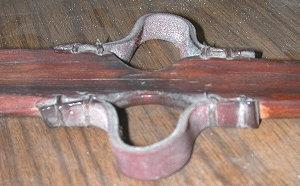
- Glue the leather straps to the sides and "sew" them on through the holes.

The website where I found this atlatl is athttp://www.utep.edu/museum/desertdiary/archive/culture/DDatlatl.htm
 Check out Bird of Prey Bannerstone Atlatl, an artistic interpretation of the traditional bannerstone atlatls, influenced by carved elements found in many artifacts.
Check out Bird of Prey Bannerstone Atlatl, an artistic interpretation of the traditional bannerstone atlatls, influenced by carved elements found in many artifacts.
Check out Bobcat Triplets, a set of genetically matched reproductions of the Key Marco Atlatl found in 1896.
Learn more about the relationship between the bow and arrow and its precursor, the atlatl and dart system.
At BPS Engineering, Atlatl Bob produces the highest quality production atlatl and dart systems for sale to the public. The Warrior Atlatl, our production model is still a high quality, hand crafted, display quality atlatl, and just happens to be the most reliable and efficient Atlatl on the market. And the production-line Penetrator Aluminum Dart is the sturdiest and most accurate Atlatl Dart avaliable.

Now Available! Check out the Atlatl documentary videostarring Atlatl Bob! This 5 minute film by Jeremy Roberts is a must-see for all Atlatl Bob fans!
You can buy your own authentic or artistic replica atlatl made by the one and only Atlatl Bob today, or if you are considering getting an atlatl and dart system for a friend or colleague as gift, you can purchase the best product from BPS Engineering.
BPS Engineering has reintroduced the Atlatl and Dart so that humans today can rediscover our past to better understand our future.

Thanks to our Stone Age Ancestors, all of us have an Atlatl in our past.
Field & Stream September 1993


No comments:
Post a Comment